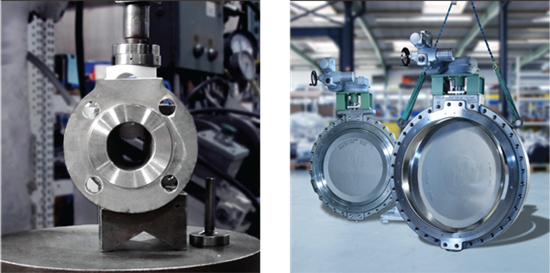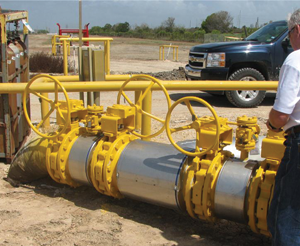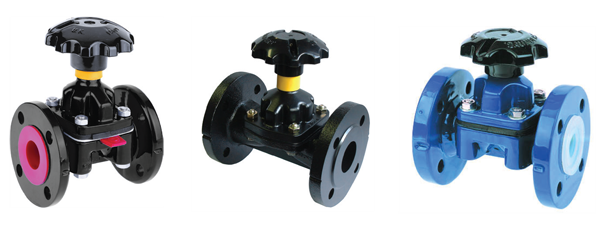The Challenges of Chlor-Alkali
With the introduction of new materials and the evolution of valve design over the years, the days when fluid handling operators were limited by the number of valve types available to control the process are long gone.
#materials
The features of the valves available for chlor-alkali plants have been customized to solve some of the most plaguing issues the industry faces. Operators today must understand the strengths of each type of valve to select the right one for different parts of the process.
CHLOR-ALKALI
In a chlor-alkali plant, four major phases occur: brine preparation, chlorine processing, caustic soda and hydrogen production. Each of them presents their own challenges as does other downstream considerations with chlor-alkali, including dealing with hydrochloric acid and with sodium hypochlorite synthesis.
Each of the four phases requires specific valves and materials.
The range of valve types created for use in chlor-alkali plants is broad: diaphragm valves, sleeved plug valves, lined valves (butterfly, ball, check and plug) and bellows-sealed globe valves, to name a few.
All of these valves face problems with fugitive emissions, which can be caused by insufficient sealing systems, thermal cycling and corrosion of wetted valve components, especially in the case of inappropriate media/lining combinations. Downstream leakage, another common problem, can result from internal corrosion, abrasion damage of seats, scaling and seat wear over time. The valves used in chlor- alkali must have features and benefits that can handle such issues.
CHALLENGES IN THE PHASES
Because of the high sensitivity of the membranes and diaphragms in the electrolytic cells used in this process, the brine solution for those cells must be purified, a process that involves numerous steps including treatment, filtration and ion exchange. In parts of the process where solids are present, abrasion is an issue. Perfluoroalkoxy (PFA)-lined diaphragm valves with a polytetrafluoroethylene (PTFE) diaphragm are often used. PFA-lined butterfly valves are also a popular choice in the brine preparation process, and PFA-lined plug and ball valves are sometimes used, particularly after filtration when solids have been removed from the media.
Chlorine is the main product of a chlor-alkali plant. This chlorine must be cooled, dried, compressed, and either liquified for storage or transporting, or sent to downstream processes. The chlorine processing section of the operation occurs after chlorine gas is generated in the electrolyzer. The most prevalent issues encountered in chlorine processing are fugitive emissions and corrosive media. The wet chlorine that comes directly from the electrolyzer is highly corrosive and toxic. A frequent choice of valve here is a high-performance butterfly valve (Figures 1 and 4), a severe service plug valve in a material such as Monel (Figure 3) or a zero-emissions valve such as a bellows-sealed globe valve. The wet chlorine is dried using concentrated sulfuric acid (H2SO4). Lined ball or plug valves are often used to deal with the highly corrosive nature of the H2SO4.
Another major byproduct of the chlor-alkali process is caustic soda, typically sodium hydroxide. Depending on the technology in use in the electrolytic cell, the caustic soda produced is in different concentrations with different levels of salt contamination. This poses valve selection challenges because the media is corrosive, but it may also contain solids, especially after evaporation to concentrate the product. As concentration increases, salt may crash out of solution (precipitate) and have scaling effects. For this reason, a sleeved plug valve in nickel alloy is often a choice (Figure 3). The absence of body cavities in this valve type prevents the accumulation of flow media, which can result in damage to the sealing surface. Valves with 360-degree port lips will protect the sleeve from any abrasion as well. In low-salt caustic applications, lined ball valves are a viable option because of their full port design and outstanding corrosion resistance.
Hydrogen gas is another byproduct produced in the chlor-alkali process. Because of unfavorable stoichiometric ratios (the exact ratio between air and flammable gas or vapor at which complete combustion takes place) and a low molecular weight, hydrogen is not produced in quantities that typically make it a commercially attractive derivative. Still, the hydrogen produced may be burned as fuel or is frequently combusted with chlorine to make hydrochloric acid for use in the plant.
The difficulties hydrogen production presents include dealing with high pressures needed for storage and the need to select a material that can avoid hydrogen embrittlement. High-performance butterfly valves (HPBVs) are a frequent choice for use in hydrogen production.
THE RIGHT VALVE
Diaphragm valves (Figure 2) are often used in chlor-alkali applications because only two parts of the valve come in contact with the line media, allowing it to resist corrosion and abrasion. The diaphragm isolates the working parts of the valve from the harmful media, further preventing corrosion of any metallic components. The linear operation of the valve assures the seal even if the diaphragm indicates signs of wear from abrasion. It also prevents break-in or break-out torque. Because of this, the rolled thread should not seize or gall, and the spindles are protected from the environment through travel, preventing valve jams. Diaphragm valves also enable a pocketless flow, which prevents buildup on sealing surfaces, facilitating complete closure.
Fully lined ball, plug and butterfly valves offer unparalleled corrosion resistance to all chemicals encountered in the chlor-alkali process.
When bellows-sealed globe valves are needed, valves with internal components made of stainless-steel or Hastelloy to provide sufficient protection against corrosion are used. This can also help to prevent abrasion with the multi-wall, fully-flushed stainless-steel bellows acting as a primary seal. This flushed system also can keep the bellows clean and free from any particles settling into the fins of the bellow.
Another favorable feature prevalent in bellows-sealed globe valves is tight sealing between the body and bonnet, which has the ability to further extend the valve’s life. A superior safety sealing system in a bellows-sealed globe valve has multiple walls, gland packing, a metal back seat and a cover gasket for fugitive emissions protection. The bellows-sealed globe valve is also useful in the prevention of thermal cycling through the tongue and groove sealing system.
CONCLUSION
Chlor-alkali is one of the most demanding fluid handling applications. A greater understanding of the challenges that operators face allows those who select the valves to weigh the benefits and features of each valve type to match them to exact needs. It’s up to the operator to ensure they partner with a valve manufacturer that has the experience and knowledge needed to supply the most appropriate valve so that the equipment can both do the job needed for smooth operation (thereby assuring best total cost of ownership), and keep personnel and the environment safe.
PHILIP SCHULTZ is application specialist–XOMOX Lined Products, Crane ChemPharma & Energy (www.cranecpe.com). Reach him at pschultz@cranecpe.com.
The Valves in Chlor-alkali Service
Hydrochloric Acid
Typical Valves:
- Diaphragm valves
- Lined ball, butterfly, check and plug valves
- Bellows sealed globe valves
Common Problems Solved:
- Downstream leakage
- External emissions
- Internal corrosion
- High maintenance costs
Brine Preparation
Typical Valves:
- Diaphragm valves
- Lined plug, butterfly and ball valves
- Bellows-sealed globe valves
Common Problems Solved:
- Particulate abrasion
- Valve jams
- Internal corrosion
- Scaling/downstream leakage
Chlorine Processing
Typical Valves:
- Diaphragm valves
- Lined butterfly, ball and plug valves
- Bellows-sealed globe valves
- Wet chlorine: lined
Common Problems Solved:
- External emissions
- Downstream leakage
- Lining permeation
- Maintenance difficulty
- Temperature cycling
Caustic Soda
Typical Valves:
- Stainless steel
- Lined butterfly and plug valves
- Sleeved plug valves
Common Problems Solved:
- External leakage
- Scaling/downstream leakage
- High temperature corrosion
RELATED CONTENT
-
Regulators versus Control Valves: What’s the Best Fit?
The combination of North American shale fields that continue to fuel high levels of new domestic oil and gas projects and ongoing global efforts means the need for efficiency in instrumentation selection has never been higher.
-
New Technologies Solve Severe Cavitation Problems
An advanced anti-cavitation control valve design enabled by 3D metal printing solved a power plant’s severe cavitation problem and dramatically improved its bottom line.
-
Understanding Torque for Quarter-Turn Valves
Valve manufacturers publish torques for their products so that actuation and mounting hardware can be properly selected.














 Unloading large gate valve.jpg;maxWidth=214)